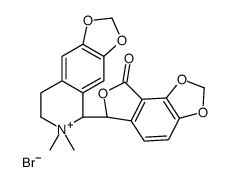(-)-BICUCULLINE METHBROMIDE

(-)-BICUCULLINE METHBROMIDE structure
|
Common Name | (-)-BICUCULLINE METHBROMIDE | ||
|---|---|---|---|---|
| CAS Number | 66016-70-4 | Molecular Weight | 462.29100 | |
| Density | N/A | Boiling Point | N/A | |
| Molecular Formula | C21H20BrNO6 | Melting Point | N/A | |
| MSDS | Chinese USA | Flash Point | N/A | |
| Symbol |


GHS06, GHS09 |
Signal Word | Danger | |
Use of (-)-BICUCULLINE METHBROMIDEBicuculline methobromide is a selective GABAA receptor antagonist with an IC50 value of 3 μM. Bicuculline methobromide induces clonic tonic convulsions in mammals and can also be used to block Ca2+ activated potassium channels. Bicuculline methobromide can be used in studies of epilepsy and other related psychiatric disorders[1][2]. |
| Name | (6R)-6-[(5S)-6,6-dimethyl-7,8-dihydro-5H-[1,3]dioxolo[4,5-g]isoquinolin-6-ium-5-yl]-6H-furo[3,4-g][1,3]benzodioxol-8-one,bromide |
|---|---|
| Synonym | More Synonyms |
| Description | Bicuculline methobromide is a selective GABAA receptor antagonist with an IC50 value of 3 μM. Bicuculline methobromide induces clonic tonic convulsions in mammals and can also be used to block Ca2+ activated potassium channels. Bicuculline methobromide can be used in studies of epilepsy and other related psychiatric disorders[1][2]. |
|---|---|
| Related Catalog | |
| In Vitro | Bicuculline methobromide (1 μM and 3 μM) attains the maximal response of GABA. Bicuculline methobromide appears to shift the dose–response curves of GABA in parallel to the right without decreasing GABA maximal response, suggesting that it is a competitive antagonist at human α1β2γ2L GABAA receptors expressed in Xenopus oocytes[3]. Bicuculline methobromide (1-100 μM; 2 min; applied as outside-out patches) potently blocks both Apamin (HY-P0256)-sensitive small-conductance calcium-activated potassium channels (SK2) currents and Apamin-insensitive SK1 currents in Xenopus oocytes[4]. |
| In Vivo | Bicuculline methobromide (subcutaneous injection, 1.25-3 mg/kg) can cause clonus-tonic convulsions in a dose-dependent manner in mice and these convulsions are enhanced by injection of the μ-opioid agonist morphine[1]. Bicuculline methobromide (subcutaneous injection, 1.5-3.2 mg/kg) induces male Swiss S mice generalized seizures with a CD50 (convulsant dose) of 2.2 mg/kg for clonus and CD50 of 2.4 mg/kg for tonus. Seizures induced by Bicuculline at the dose of 3.2 mg/kg can be blocked by pretreatment (i.p.) with the NMDA antagonists MK-801, CPP and CGS 19755[2]. |
| References |
| Molecular Formula | C21H20BrNO6 |
|---|---|
| Molecular Weight | 462.29100 |
| Exact Mass | 461.04700 |
| PSA | 63.22000 |
| Symbol |


GHS06, GHS09 |
|---|---|
| Signal Word | Danger |
| Hazard Statements | H300-H311 + H331-H410 |
| Precautionary Statements | P261-P264-P273-P280-P301 + P310-P311 |
| Personal Protective Equipment | Eyeshields;Gloves;type N95 (US);type P1 (EN143) respirator filter |
| Safety Phrases | 24/25 |
| RIDADR | UN 1544 6.1/PG 2 |
|
Correlated changes in NMDA receptor phosphorylation, functional activity, and sedation by chronic ethanol consumption.
J. Neurochem. 115(5) , 1112-22, (2010) Alcohol abuse leads to tolerance, dependence, and memory impairments that involve excitatory glutamatergic NMDA synaptic transmission. The NMDA receptor (NMDAR) is known to undergo activity-dependent ... |
|
|
Further characterization of the anorexic action of orally-administered THIP, a GABA-analogue, in the rat.
Physiol. Behav. 29(5) , 901-4, (1982) Sprague-Dawley rats were used to further characterize the anorexic action of orally-administered THIP, a GABA-analogue. The anorexic action of THIP (5 or 10 mg/kg) was antagonized by prior subcutaneou... |
|
|
Increased c-Fos expression in select lateral parabrachial subnuclei following chemical versus electrical stimulation of the dorsal periaqueductal gray in rats.
Brain Res. 974(1-2) , 153-66, (2003) The parabrachial nucleus (PBN) is located in the rostral dorsolateral pons and has been identified as a critical relay for cardiovascular responses (sympathoexcitation and baroreflex attenuation) evok... |
| (-)-Bicuculline methbromide,1(S),9(R) |
| (-)-Bicuculine Methbromide |
| Bicuculline methobromide |
| (-)-Bicuculline Methbromide |
| HMS2234F21 |